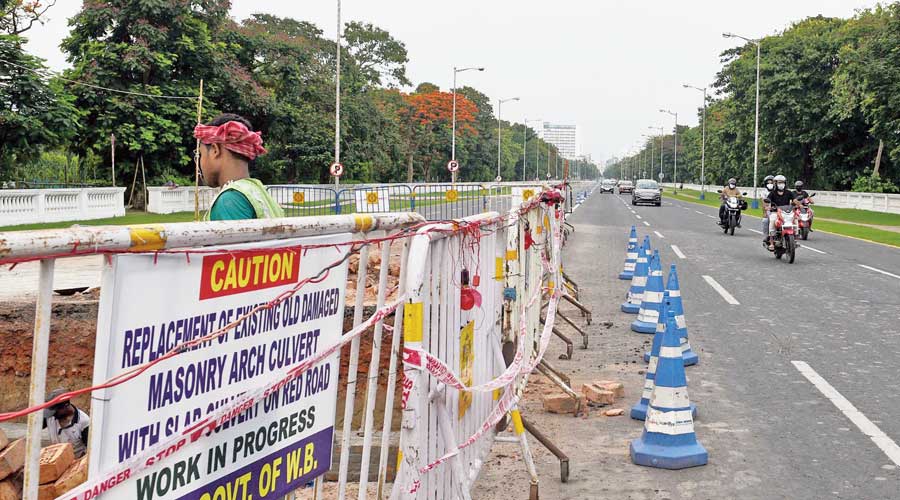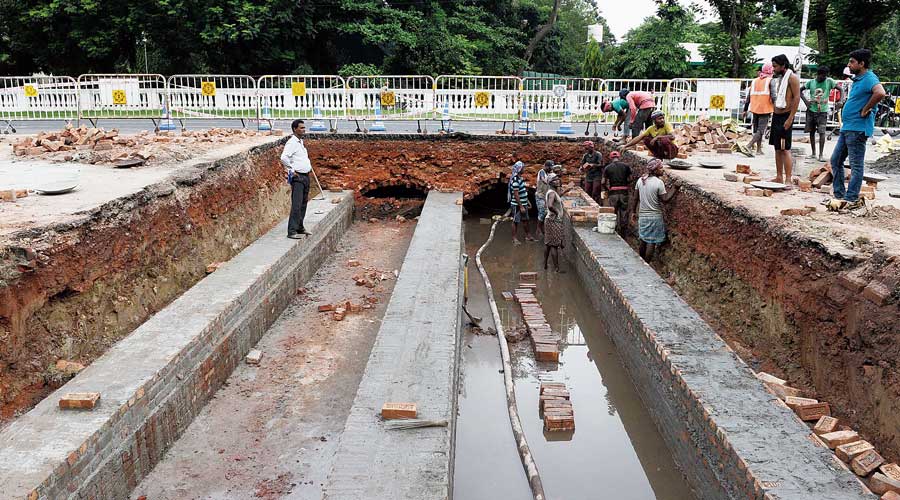The 201-year-old Red Road has been dug up for the first time in many decades so a brick culvert built by the British can be repaired. The culvert contains two tunnels that connect the Hooghly with the city and runs under the Maidan, unbeknownst to thousands who commute through that stretch or play on the green sprawl.
Special job
At least two public works department engineers told The Telegraph that Red Road had never been dug up like this before.
Function of the tunnels
They are meant to drain water from the Maidan into the river. They do the opposite as well — bring water from the river during very high tides. This water often floods parts of the Maidan.
Football fans are familiar with the Mohun Bagan Club tent getting flooded occasionally.
Nilangshu Basu, a former chief municipal engineer who had led the team of engineers that desilted the city’s British built underground sewer network, said a moat was built around Fort William when it was shifted to its current location.

A portion of Red Road cordoned off for work. Pradip Sanyal
“To fill the channel with water, it was connected with the drainage system of places like Park Street and Lindsay Street. The water from these places used to flow into the moat,” he said.
The channel was subsequently filled up with earth and over the years, a drainage network was built to remove water from Park Street and neighbouring places.
The sewage from these areas now flows towards AJC Bose Road. But water in the Maidan area still flows through the two channels that pass under Red Road.
Reason for repair
An overflow from an open channel near Mohun Bagan Club after a spell of rain in the last week of May and reappearance of a depression on Red Road even after a repair work on the surface gave PWD
officials an impression that the flow of underground water was being interrupted.
“We tried to repair Red Road from the surface but the depression occurred again after a few days. We realised the problem was underground. So the decision to dig Red Road was taken,” said a senior PWD engineer.
The job at hand
The broken masonry arch culvert is more than 5feet underground. The arch will be replaced by a rectangular slab to make the structure more sustainable, an official said. The officials, however, refused to divulge more details as the “project is very sensitive”.
Tunnel composition
The two-century-old structure has multiple layers of bricks placed one after the other to support the weight of vehicles passing through Red Road.
Time needed
Work is likely to be completed by 10pm on June 17.
History of Red Road
Earlier known as the “Secretary’s Walk”, the present Red Road is believed to have been constructed in 1820 to connect the Governor General’s residence (now Raj Bhavan) to the southern part of the city, said urban historian Debasis Bose.
“This used to be the principal road for the movement of the secretary to the governor general.”
Red Road allowed the officials to bypass the more congested roads that connect
Kidderpore (Calcutta’s port area) to the heart of the city via Old Court House Street, Mission Row and Brabourne Road.
Story behind the name
Legend has it that when the thoroughfare was being constructed, the stretch used to be covered with a layer of red brick chips. People started calling it Red Road. Bose said the road had also been referred to as the “Lady’s Mile” in several history books on Calcutta, presumably because white women would take a stroll on the stretch in the morning and the evening.











